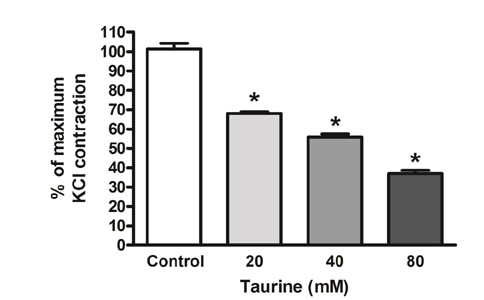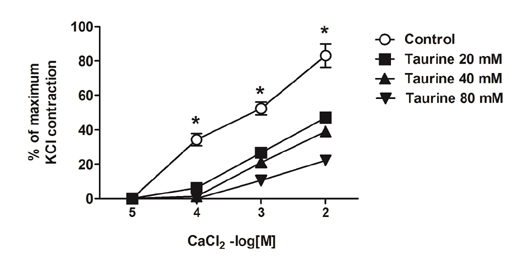Korean J Physiol Pharmacol.
2017 Nov;21(6):617-623. 10.4196/kjpp.2017.21.6.617.
Taurine relaxes human radial artery through potassium channel opening action
- Affiliations
-
- 1Department of Medical Pharmacology, Gulhane Faculty of Medicine, University of Health Sciences, Ankara 06018, Turkey. oguzhany01@gmail.com
- 2Department of Cardiovascular Surgery, Gulhane Faculty of Medicine, University of Health Sciences, Ankara 06018, Turkey.
- 3Department of Anesthesiology, Gulhane Faculty of Medicine, University of Health Sciences, Ankara 06018, Turkey.
- 4Department of Cardiovascular Surgery, Guven Hospital, Ankara 06540, Turkey.
- 5Department of Cardiovascular Surgery, Gaziantep Faculty of Medicine, Gaziantep University, Gaziantep 27310, Turkey.
- KMID: 2395256
- DOI: http://doi.org/10.4196/kjpp.2017.21.6.617
Abstract
- The vascular actions and mechanisms of taurine were investigated in the isolated human radial artery (RA). RA rings were suspended in isolated organ baths and tension was recorded isometrically. First, a precontraction was achieved by adding potassium chloride (KCl, 45 mM) or serotonin (5-hydroxytryptamine, 5-HT, 30 µM) to organ baths. When the precontractions were stable, taurine (20, 40, 80 mM) was added cumulatively. Antagonistic effect of taurine on calcium chloride (10 µM to 10 mM)-induced contractions was investigated. Taurine-induced relaxations were also tested in the presence of the K⺠channel inhibitors tetraethylammonium (1 mM), glibenclamide (10 µM) and 4-aminopyridine (1 mM). Taurine did not affect the basal tone but inhibited the contraction induced by 5-HT and KCl. Calcium chloride-induced contractions were significantly inhibited in the presence of taurine (20, 40, 80 mM) (p<0.05). The relaxation to taurine was inhibited by tetraethylammonium (p<0.05). However, glibenclamide and 4-aminopyridine did not affect taurine-induced relaxations. Present experiments show that taurine inhibits 5-HT and KCl-induced contractions in RA, and suggest that large conductance Ca²âº-activated K⺠channels may be involved in taurine-induced relaxation of RA.
Keyword
MeSH Terms
-
4-Aminopyridine
Baths
Calcium
Calcium Chloride
Glyburide
Humans*
Potassium Channels*
Potassium Chloride
Potassium*
Radial Artery*
Relaxation
Serotonin
Taurine*
Tetraethylammonium
Vasodilation
4-Aminopyridine
Calcium
Calcium Chloride
Glyburide
Potassium
Potassium Channels
Potassium Chloride
Serotonin
Taurine
Tetraethylammonium
Figure
Reference
-
1. Huxtable RJ. Physiological actions of taurine. Physiol Rev. 1992; 72:101–163.2. Oja SS, Saransaari P. Pharmacology of taurine. Proc West Pharmacol Soc. 2007; 50:8–15.3. Militante JD, Lombardini JB. Treatment of hypertension with oral taurine: experimental and clinical studies. Amino Acids. 2002; 23:381–393.4. Kohashi N, Katori R. Decrease of urinary taurine in essential hypertension. Jpn Heart J. 1983; 24:91–102.5. Abebe W, Mozaffari MS. Role of taurine in the vasculature: an overview of experimental and human studies. Am J Cardiovasc Dis. 2011; 1:293–311.6. Franconi F, Giotti A, Manzini S, Martini F, Stendardi I, Zilletti L. The effect of taurine on high potassium- and noradrenaline-induced contraction in rabbit ear artery. Br J Pharmacol. 1982; 75:605–612.7. Ristori MT, Verdetti J. Effects of taurine on rat aorta in vitro. Fundam Clin Pharmacol. 1991; 5:245–258.8. Li N, Sawamura M, Nara Y, Ikeda K, Yamori Y. Direct inhibitory effects of taurine on norepinephrine-induced contraction in mesenteric artery of stroke-prone spontaneously hypertensive rats. Adv Exp Med Biol. 1996; 403:257–262.9. Niu LG, Zhang MS, Liu Y, Xue WX, Liu DB, Zhang J, Liang YQ. Vasorelaxant effect of taurine is diminished by tetraethylammonium in rat isolated arteries. Eur J Pharmacol. 2008; 580:169–174.10. Liu Y, Niu L, Zhang W, Cui L, Zhang X, Liang Y, Zhang M. Effects of taurine on contractions of the porcine coronary artery. Pharmacol Rep. 2009; 61:681–689.11. Karabacak K, Kaya E, Ulusoy KG, Seyrek M, Kurtoglu M, Doganci S, Yildirim V, Yildiz O, Demirkilic U. Effects of taurine on contractions of human internal mammary artery: a potassium channel opening action. Eur Rev Med Pharmacol Sci. 2015; 19:1498–1504.12. He GW. Verapamil plus nitroglycerin solution maximally preserves endothelial function of the radial artery: comparison with papaverine solution. J Thorac Cardiovasc Surg. 1998; 115:1321–1327.13. Nisanoglu V, Battaloglu B, Ozgur B, Eroglu T, Erdil N. Topical vasodilators for preventing radial artery spasm during harvesting for coronary revascularization: comparison of 4 agents. Heart Surg Forum. 2006; 9:E807–E812.14. Yildiz O, Seyrek M, Gul H. Pharmacology of arterial grafts for coronary artery bypass surgery. In : Aronow WS, editor. Artery bypass. Croatia: Intech;2013. p. 251–276.15. Mussa S, Choudhary BP, Taggart DP. Radial artery conduits for coronary artery bypass grafting: current perspective. J Thorac Cardiovasc Surg. 2005; 129:250–253.16. Possati G, Gaudino M, Prati F, Alessandrini F, Trani C, Glieca F, Mazzari MA, Luciani N, Schiavoni G. Long-term results of the radial artery used for myocardial revascularization. Circulation. 2003; 108:1350–1354.17. Seyrek M, Yildiz O, Ulusoy HB, Yildirim V. Testosterone relaxes isolated human radial artery by potassium channel opening action. J Pharmacol Sci. 2007; 103:309–316.18. Yildiz O, Seyrek M, Un I, Gul H, Candemir G, Yildirim V. The relationship between risk factors and testosterone-induced relaxations in human internal mammary artery. J Cardiovasc Pharmacol. 2005; 45:4–7.19. Guven G, Seyrek M, Vural IM, Cehreli ZC, Yildiz O. Vasodilatory effect of hydroxyethyl methacrylate and triethylene glycol dimethacrylate in rat aorta through calcium antagonistic action. J Endod. 2011; 37:353–357.20. Quayle JM, McCarron JG, Brayden JE, Nelson MT. Inward rectifier K+ currents in smooth muscle cells from rat resistance-sized cerebral arteries. Am J Physiol. 1993; 265:C1363–C1370.21. Xue WX, Zhang MS, Niu LG, Liu Y, Liang YQ. Vasodilation effects and mechanism of taurine on rat thoracic aortas. Chin J Pharmacol Toxicol. 2007; 21:23–27.22. Tosun M, Paul RJ, Rapoport RM. Intracellular Ca2+ elevation and contraction due to prostaglandin F2alpha in rat aorta. Eur J Pharmacol. 1997; 340:203–208.23. Xue W, Zhang M, Li J, Wu D, Niu L, Liang Y. Effects of taurine on aortic rings isolated from fructose-fed insulin resistance Sprague-Dawley rat are changed. Cardiovasc Drugs Ther. 2008; 22:461–468.24. Briel G, Gylfe E, Hellman B, Neuhoff V. Microdetermination of free amino acids in pancreatic islets isolated from obese-hyperglycemic mice. Acta Physiol Scand. 1972; 84:247–253.25. Morán J, Hernández-Pech X, Merchant-Larios H, Pasantes-Morales H. Release of taurine in apoptotic cerebellar granule neurons in culture. Pflugers Arch. 2000; 439:271–277.26. Song D, O'Regan MH, Phillis JW. Mechanisms of amino acid release from the isolated anoxic/reperfused rat heart. Eur J Pharmacol. 1998; 351:313–322.27. Lambert IH, Kristensen DM, Holm JB, Mortensen OH. Physiological role of taurine—from organism to organelle. Acta Physiol (Oxf). 2015; 213:191–212.28. Schaffer SW, Jong CJ, Ito T, Azuma J. Effect of taurine on ischemiareperfusion injury. Amino Acids. 2014; 46:21–30.
- Full Text Links
- Actions
-
Cited
- CITED
-
- Close
- Share
- Similar articles
-
- Activation of the Cardiac ATP-Sensitive K+Channel by KR-30816,Newly Synthesized Potassium Channel Opener
- K+ channel
- Effects of PGI2 on the ATP-sensitive Potassium Channel Activity in the Isolated Rat Cardiac Myocytes
- Actions of potassium channel openers in rat detrusor urinae
- Beneficial Effects of Taurine on Metabolic Parameters in Animals and Humans







